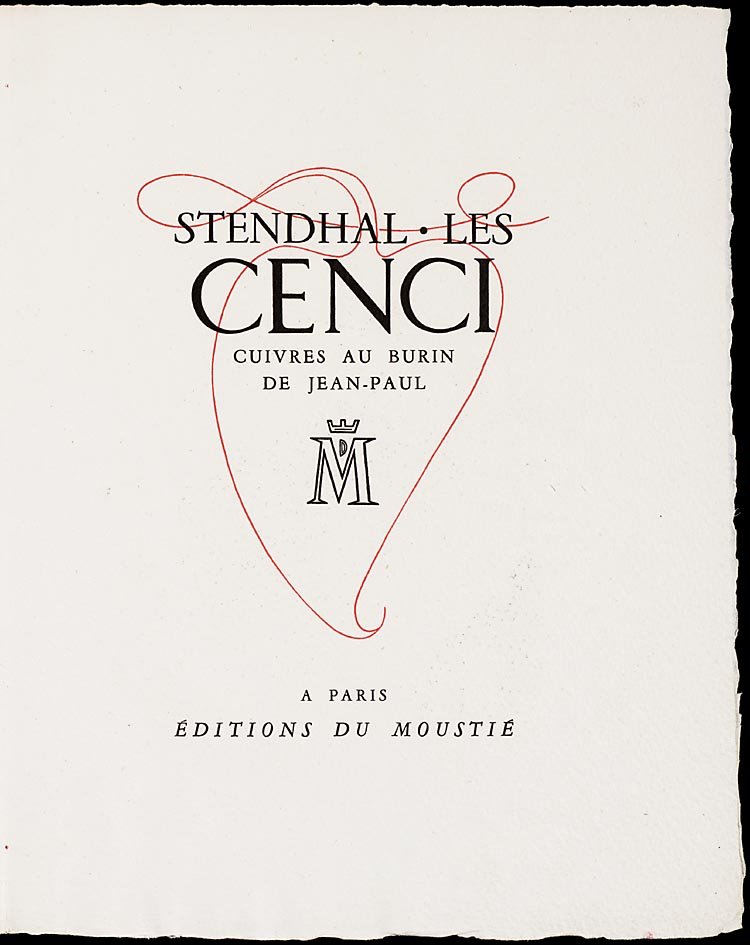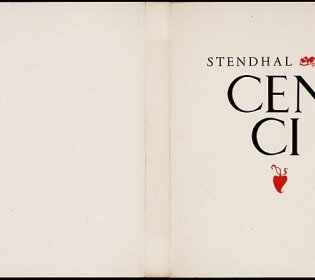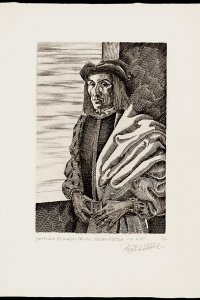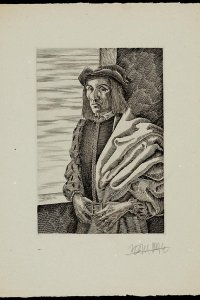Cenci
-
Year:
-
1946
-
Author:
-
Stendhal (1783 - 1842)
-
Artist:
-
Jean-Paul Vroom (1922 - 2006)
-
Publisher:
-
Éditions du Moustié
An Italian Don Juan
Stendhal's loose, sometimes careless style is often contrasted with Flaubert's polished, precise use of language. Stendhal was popular in the Netherlands during the 1920s and 1930s among the 'Forum generation', especially for his autobiographical writings. Inspired by Shakespeare and always in love with anecdotes, Stendhal used ancient sources for his stories. He adapted sixteenth-century Italian chronicles in several novels, full of violence, love and sex. One of these stories, Les Cenci, deals with an Italian variant of the Don Juan character. The story was first published in the magazine La revue des deux mondes in July 1837, and was reprinted posthumously in 1855 with his other Italian stories in the collection Les chroniques italiennes.
The story of the Cenci family is tragic because of the acts of father Francesco Cenci, who pursues several romances, ends up in prison, but even after this experience continues to taunt and abuse his wife and children so much that they hire someone to murder him. The murder attempt fails, the father takes revenge and his wife and children are beheaded by the executioner one by one. The story holds sufficient drama for an illustrated edition, which duly appeared. Publisher Moustié (Robert-Marin) in Paris commissioned an illustrator identified only as 'Jean-Paul' - perhaps in memory of the famous illustrator Hermann-Paul, who died in 1940. Nothing seems to be known about this artist, which is hardly surprising because the name Jean-Paul is a combination of two Christian names, and his full name is listed neither in the book nor in reference works or any bibliographies. But there is a solution to this riddle.
Hidden identity
390 copies of this edition were published on Puymoyen paper, and another 40 copies were printed for the publisher and his friends and relations. A small number of additional copies were printed especially for the illustrator, and were signed by him. The Koopman Collection owns one of these special artist's copies of Les Cenci. The signature includes his full name, which turns out to be Jean-Paul Vroom (born in The Hague, named Johannes Paul Vroom). This painter, graphic artist, filmmaker, photographer and engraver worked for the theatre and in advertising from 1936 onwards. His father, a stamp-maker, taught him the art of engraving. He began his studies in The Hague, and continued them in Paris at the Ecole Estienne, where he lived from 1943 to 1955. From 1945 onwards, he also illustrated special bibliophilic book editions, some of which he published independently (including work by Daudet and Hugnet). Les Cenci was his first commission. He became known in the Netherlands for his illustrations and typography for the editions of Stichting De Roos and by his collaboration with choreographer Hans van Manen (for whom he designed the sets and costumes for his well-known ballet 'Adagio Hammerklavier').
Vroom produced tightly designed steel engravings for Les Cenci, which he first drafted in little pencil drawings. This process can be traced in full in the Koopman copy, numbered 'B', which contains more than the regular number of illustrations. Also included are a suite of copper engravings in two stages, the suite of rejected engravings, and the addition of an original drawing. This drawing was made for the engraving in which the priest steps onto the scaffold to support the convicts in their final minutes. It was developed into an engraving in a number of stages, and was subsequently printed in Paul Haasen's studio. The engravings in the suite have been signed and dated. Work on the book began in 1944, but the first stages of the engravings date from 12 to 20 July 1945, and the second from 1 to 23 July 1945. The text was printed by A. and P. Jarach at printing business La Ruche. The frontispiece is a portrait of Stendhal bearing a fringe of beard. The copper engraving was based on a drawing by Henry Lehmann. This was the last portrait of the author to be produced during his lifetime. Stendhal was living in Italy, had already suffered cerebral haemorrhage, and was partially paralyzed in his face and hands. It was August 1841, and his face is strained in a benevolent but painful smile. Six months later, he suffered a second, lethal haemorrhage.
Bibliographical description
- Description:
- Les Cenci / Stendhal ; cuivres au burin de Jean-Paul [Vroom]. - Paris : Éditions du Moustié, 1946. - [73] p. : ill. ; 31 cm
- 1st edition:
- In: Les chroniques italiennes, 1855
- Printer:
- La Ruche (A. en P. Jarach) (text); Paul Haasen (etchings)
- Edition:
- 430 copies
- This copy:
- Copy of the artist, no. B
- Note:
- With two extra sets of the etchings, dated and signed by the artist, and with one original drawing; Signed by Jean Paul Vroom
- Bibliography:
- Carteret IV-367 ; Monod 10421
- Shelfmark:
- Koopm A 321
References
- Michel Crouzet, Stendhal ou Monsieur Moi-même. Paris, Flammarion, 1990
- V. Del Litto, Album Stendhal. Paris, Gallimard, 1966
- [Jean-Paul Vroom]. Leiden, Stedelijk Museum De Lakenhal, 1963(Tentoonstellingscatalogus)
- Henri Martineau, Le calendrier de Stendhal. Paris, Divan, 1950
- [Stendhal], Chroniques italiennes, Tome premier. Nouv. éd. Genève, Cercle du bibliophile, 1968
- [Stendhal], Stendhal et la Hollande: correspondance administrative inédite 1810-1812. London, Institute of Romance Studies, University of London School of Advanced Study, 1996




![Page [21] with etching by Jean-Paul Vroom](/sites/default/files/styles/galerie/public/images/cenci-p21.jpg?h=823c10a2&itok=EPrVeCDL)


